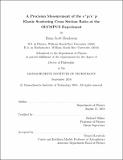A precision measurement of the e⁺p/e⁻p elastic scattering cross section ratio at the OLYMPUS experiment
Author(s)
Henderson, Brian Scott
DownloadFull printable version (19.84Mb)
Other Contributors
Massachusetts Institute of Technology. Department of Physics.
Advisor
Richard Milner.
Terms of use
Metadata
Show full item recordAbstract
Measurements of the ratio of the proton elastic form factors ([mu]pGe/Gm) using Rosenbluth separation and those using polarization-based techniques show a strong discrepancy, which has persisted both in modern experimental results and in re-analyses of previous data. The most widely accepted hypothesis to explain this discrepancy is the treatment of the contributions from hard two-photon exchange (TPE) to elastic electron-proton scattering in the radiative corrections applied to the Rosenbluth separation measurements. Calculations of the hard TPE contribution are highly model dependent, but the effect may be measured experimentally with a precise determination of the ratio of the positron-proton and electron-proton elastic scattering cross sections. The OLYMPUS experiment collected approximately 4 fb-1 of e+p and e-p scattering data at the DORIS storage ring at DESY in 2012, with the goal of measuring the elastic [sigma]e+p/[sigma]e-p ratio over the kinematic range (0.4 < c < 0.9), (0.6 < Q2 < 2.2) GeV2 /c 2 at a fixed lepton beam energy of 2.01 GeV. The detector for the OLYMPUS experiment consisted of refurbished elements of the Bates Large Acceptance Spectrometer Toroid (BLAST) surrounding an internal gaseous hydrogen target, with the addition of multiple systems for the monitoring of the luminosity collected by the experiment. A detailed simulation of the experiment was developed to account for both radiative corrections and various systematic effects. This work presents preliminary results from the OLYMPUS data, demonstrating that the elastic [sigma]e+p/[sigma]e-p ratio rises to several percent at [epsilon] ~~ 0.4 and indicating a significant contribution from TPE to e± p scattering. Additionally, the value of [sigma]e+p/[sigma]e-p has been measured to unprecedented precision at [epsilon] = 0.98, which provides a valuable normalization point for other experimental data.
Description
Thesis: Ph. D., Massachusetts Institute of Technology, Department of Physics, 2016. Cataloged from PDF version of thesis. Includes bibliographical references (pages 275-288).
Date issued
2016Department
Massachusetts Institute of Technology. Department of PhysicsPublisher
Massachusetts Institute of Technology
Keywords
Physics.